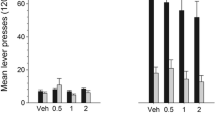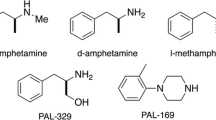Abstract
Rationale
The D2-like receptor partial agonist terguride has a profile of behavioral effects in rats that suggests potential benefit as a pharmacotherapy for cocaine addiction.
Objectives
The present study investigated the effects of terguride on cocaine- and food-maintained behavior in squirrel monkeys.
Methods
Squirrel monkeys were trained to respond on a second-order schedule (FI 10 min, FR 10 or 30:S) of either i.v. cocaine injection or food pellet delivery. Additional monkeys were studied using quantitative observational techniques to construct side effect profiles. Under each procedure, the effects of terguride were compared with those of the reference D2-like receptor antagonist nemonapride and the D2-like receptor full agonist quinpirole.
Results
Terguride and nemonapride, but not quinpirole, dose-dependently reduced cocaine-maintained behavior. In animals self-administering food, terguride decreased response rates at doses lower than those required to suppress cocaine-maintained behavior. Effective doses of terguride had no systematic effect on motor activity or muscle rigidity, whereas effective doses of nemonapride virtually eliminated motor activity and induced severe catalepsy. The primary observable effects of terguride were a modest increase in self-directed behavior (a D2-receptor agonist-like effect) at intermediate doses and a small increase in static posture (a D2-receptor antagonist-like effect) at the highest dose tested.
Conclusions
The results suggest that terguride has advantages over conventional D2-like receptor antagonists and agonists as a candidate pharmacotherapy for cocaine abuse; however, terguride significantly reduces food-maintained behavior at lower doses than those needed to decrease cocaine-maintained behavior suggesting limitations on the utility of terguride as a medication for cocaine addiction.



Similar content being viewed by others
References
Ariëns EJ (1983) Intrinsic activity: partial agonists and partial antagonists. J Cardiovasc Pharmacol 5:S8–S15
Arnt J, Hyttel J (1990) Dopamine D-2 agonists with high and low efficacies: differentiation by behavioural techniques. J Neural Transm Gen Sect 80:33–50
Bergman J, Rosenzweig-Lipson S (1992) Cocaine-antagonist effects of limited-efficacy D1 agonists. NIDA Res Monogr 119:185–189
Bergman J, Madras BK, Johnson SE, Spealman RD (1989) Effects of cocaine and related drugs in nonhuman primates. III. Self-administration by squirrel monkeys. J Pharmacol Exp Ther 251:150–155
Bergman J, Madras BK, Spealman RD (1991) Behavioral effects of D1 and D2 dopamine receptor antagonists in squirrel monkeys. J Pharmacol Exp Ther 258:910–917
Bergman J, France CP, Holtzman SG, Katz JL, Koek W, Stephens DN (2000) Agonist efficacy, drug dependence, and medications development: preclinical evaluation of opioid, dopaminergic, and GABAA-ergic ligands. Psychopharmacology 153:67–84
Braun AR, Laruelle M, Mouradian MM (1997) Interactions between D1 and D2 dopamine receptor family agonists and antagonists: the effects of chronic exposure on behavior and receptor binding in rats and their clinical implications. J Neural Transm 104:341–362
Caine SB, Koob GF (1993) Modulation of cocaine self-administration in the rat through D-3 dopamine receptors. Science 260:1814–1816
Caine SB, Koob GF, Parsons LH, Everitt BJ, Schwartz JC, Sokoloff P (1997) D3 receptor test in vitro predicts decreased cocaine self-administration in rats. Neuroreport 8:2373–2377
Caine SB, Negus SS, Mello NK, Bergman J (1999) Effects of dopamine D1-like and D2-like agonists in rats that self-administer cocaine. J Pharmacol Exp Ther 291:353–360
Caine SB, Negus SS, Mello NK (2000) Effects of dopamine D1-like and D2-like agonists on cocaine self-administration in rhesus monkeys: rapid assessment of cocaine dose-effect functions. Psychopharmacology 148:41–51
Callahan PM, Cunningham KA (1993) Discriminative stimulus properties of cocaine in relation to dopamine D2 receptor function in rats. J Pharmacol Exp Ther 266:585–592
Carey GJ, Spealman RD (1998) CNS-neurological models of disease: substance abuse/self-administration. In: Enna S, Williams M, Ferkany J, Kenakin T, Porsolt R, Sullivan J (eds) Current protocols in pharmacology. Wiley, New York, pp 10.5.1–10.5.15
Grech DM, Spealman RD, Bergman J (1996) Self-administration of D1 receptor agonists by squirrel monkeys. Psychopharmacology 125:97–104
Hernandez L, Hoebel BG (1988) Food reward and cocaine increase extracellular dopamine in the nucleus accumbens as measured by microdialysis. Life Sci 42:1705–1712
Hopf S, Hartmann-Wiesner E, Kuhlmorgen B, Mayer S (1974) The behavioral repertoire of the squirrel monkey (Saimiri). Folia Primatol (Basel) 21:225–249
Hurd YL, Kehr J, Ungerstedt U (1988) In vivo microdialysis as a technique to monitor drug transport: correlation of extracellular cocaine levels and dopamine overflow in the rat brain. J Neurochem 51:1314–1316
Izzo E, Orsini C, Koob GF, Pulvirenti L (2001) A dopamine partial agonist and antagonist block amphetamine self-administration in a progressive ratio schedule. Pharmacol Biochem Behav 68:701–708
Katz JL, Witkin JM (1992) Selective effects of the D1 dopamine receptor agonist, SKF 38393, on behavior maintained by cocaine injection in squirrel monkeys. Psychopharmacology 109:241–244
Kenakin T (1997) Pharmacological analysis of drug-receptor interaction, 3rd edn. Lippincott-Raven, New York
Khroyan TV, Barrett-Larimore RL, Rowlett JK, Spealman RD (2000) Dopamine D1- and D2-like receptor mechanisms in relapse to cocaine-seeking behavior: effects of selective antagonists and agonists. J Pharmacol Exp Ther 294:680–687
Kleven MS, Woolverton WL (1990) Effects of bromocriptine and desipramine on behavior maintained by cocaine or food presentation in rhesus monkeys. Psychopharmacology 101:208–213
Koller WC, Rueda MG (1998) Mechanism of action of dopaminergic agents in Parkinson's disease. Neurology 50:S11–S48
Mello NK, Negus SS (1996) Preclinical evaluation of pharmacotherapies for treatment of cocaine and opioid abuse using drug self-administration procedures. Neuropsychopharmacology 14:375–424
Meltzer HY (1993) New drugs for the treatment of schizophrenia. Schizophrenia 16:365–385
Mendelson JH, Mello NK (1996) Management of cocaine abuse and dependence. N Engl J Med 334:965–972
Myers JL, Well AD (1995) Research design and statistical analysis. Lawrence Erlbaum, Hillsdale
Osborne PG, O'Connor WT, Beck O, Ungerstedt U (1994) Acute versus chronic haloperidol: relationship between tolerance to catalepsy and striatal and accumbens dopamine, GABA and acetylcholine release. Brain Res 634:20–30
Pellón R, Flores P, Alling K, Witkin JM, Katz JL (1995) Pharmacological analysis of the scratching produced by dopamine D2 agonists in squirrel monkeys. J Pharmacol Exp Ther 273:138–145
Pettit HO, Justice JB (1989) Dopamine in the nucleus accumbens during cocaine self-administration as studied by in vivo microdialysis. Pharmacol Biochem Behav 34:899–904
Piercey MF, Hoffmann WE, Vogelsang GD, Travis M (1987) Electrophysiological evaluation of a partial agonist of dopamine receptors. J Pharmacol Exp Ther 243:391–396
Piercey MF Hoffmann WE, Smith MW, Hyslop DK (1996) Inhibition of dopamine neuron firing by pramipexole, a dopamine D3 receptor-preferring agonist: comparison to other dopamine receptor agonists. Eur J Pharmacol 312:35–44
Platt DM, Rowlett JK, Spealman RD (2000) Dissociation of cocaine-antagonist properties and motoric effects of the D1 receptor partial agonists SKF 83959 and SKF 77434. J Pharmacol Exp Ther 293:1017–1026
Platt DM, Rowlett JK, Spealman RD (2001) Modulation of cocaine and food self-administration by low- and high-efficacy D1 agonists in squirrel monkeys. Psychopharmacology 157:208–216
Platt DM, Rowlett JK, Spealman RD (2002) Behavioral effects of cocaine and dopaminergic strategies for preclinical medication development. Psychopharmacology 163:265–282
Pulvirenti L, Koob GF (1994) Dopamine receptor agonists, partial agonists and psychostimulant addiction. Trends Pharmacol Sci 15:374–379
Pulvirenti L, Balducci C, Piercy M, Koob GF (1998) Characterization of the effects of the partial dopamine agonist terguride on cocaine self-administration in the rat. J Pharmacol Exp Ther 286:1231–1238
Ranaldi R, Wang Z, Woolverton WL (2001) Reinforcing effects of D2 dopamine receptor agonists and partial agonists in rhesus monkeys. Drug Alcohol Depend 64:209–217
Ritz MC, Lamb RJ, Goldberg SR, Kuhar MJ (1987) Cocaine receptors on dopamine transporters are related to self-administration of cocaine. Science 237:1219–1223
Sokoloff P, Giros B, Martres MP, Bouthenet ML, Schwartz JC (1990) Molecular cloning and characterization of a novel dopamine receptor (D3) as a target for neuroleptics. Nature 347:146–151
Spealman RD (1995) Discriminative stimulus effects of cocaine in squirrel monkeys: lack of antagonism by the dopamine D2 partial agonists terguride, SDZ 208–911, and SDZ 208–912. Pharmacol Biochem Behav 51:661–665
Spealman RD, Bergman J, Madras BK, Kamien JB, Melia KF (1992) Role of D1 and D2 dopamine receptors in the behavioral effects of cocaine. Neurochem Int 20:147S–152S
Stephens DN, Loschmann PA, Lanzinger C, Wachtel H, Montgomery AM, Herberg LJ (1990) Unusual interactions between the neuroleptic haloperidol, and the dopamine D2 partial agonist, terguride. Behav Pharmacol 1:521–529
Svensson K, Ekman A, Piercey MF, Hoffman WE, Lum JT, Carlsson A (1991) Effects of the partial dopamine receptor agonists SDZ 208–911, SDZ 208–912 and terguride on central monoamine receptors: a behavioral, biochemical and electrophysiological study. Naunyn Schmiedebergs Arch Pharmacol 344:263–274
Wachtel H, Dorow R (1983) Dual action on central dopamine function of transdihydrolisuride, a 9, 10-dihydrogenated analogue of the ergot dopamine agonist lisuride. Life Sci 32:421–432
Warner EA, Kosten TR, O'Connor PG (1997) Pharmacotherapy for opioid and cocaine abuse. Med Clin North Am 81:909–25
Weed MR, Woolverton WL (1995) The reinforcing effects of dopamine D1 receptor agonists in rhesus monkeys. J Pharmacol Exp Ther 275:1367–1374
Woolverton WL, Virus RM (1989) The effects of a D1 and a D2 dopamine antagonist on behavior maintained by cocaine or food. Pharmacol Biochem Behav 32:691–697
Acknowledgements
We thank A. Duggan, B. Platt, N. Rosenberg and E. Walker for technical assistance. This research was supported by USPHS grants DA00499 and RR00168. Preliminary reports were presented at the 2002 meeting of the College on Problems of Drug Dependence.
Author information
Authors and Affiliations
Corresponding author
Rights and permissions
About this article
Cite this article
Platt, D.M., Rodefer, J.S., Rowlett, J.K. et al. Suppression of cocaine- and food-maintained behavior by the D2-like receptor partial agonist terguride in squirrel monkeys. Psychopharmacology 166, 298–305 (2003). https://doi.org/10.1007/s00213-002-1347-0
Received:
Accepted:
Published:
Issue Date:
DOI: https://doi.org/10.1007/s00213-002-1347-0




